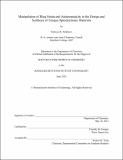| dc.contributor.advisor | Timothy M. Swager. | en_US |
| dc.contributor.author | Parkhurst, Rebecca R. (Rebecca Rosenberg) | en_US |
| dc.contributor.other | Massachusetts Institute of Technology. Dept. of Chemistry. | en_US |
| dc.date.accessioned | 2012-09-26T14:17:52Z | |
| dc.date.available | 2012-09-26T14:17:52Z | |
| dc.date.issued | 2012 | en_US |
| dc.identifier.uri | http://hdl.handle.net/1721.1/73177 | |
| dc.description | Thesis (Ph. D.)--Massachusetts Institute of Technology, Dept. of Chemistry, 2012. | en_US |
| dc.description | This electronic version was submitted by the student author. The certified thesis is available in the Institute Archives and Special Collections. | en_US |
| dc.description | "June 2012." Vita. Cataloged from student-submitted PDF version of thesis. | en_US |
| dc.description | Includes bibliographical references. | en_US |
| dc.description.abstract | Polycyclic aromatic hydrocarbons (PAHs) and fully-conjugated ladder polymers are leading candidates for organics electronics, as their inherent conformational rigidity encourages electron delocalization. Many of these systems consist of fused benzenoid or heterocyclic aromatic rings. Less frequently, however, PAHs are reported with character that alternates between the aromaticity of benzene fragments and the antiaromaticity of a nonbenzenoid moiety. Due to its high degree of unsaturation and ring strain, 3,4-bis(methylene)cyclobutene presents an intriguing building block for a variety of polycyclic macromolecules. The syntheses of several derivatives of 3,4-bis(benzylidene)cyclobutene are reported. Previously unknown 1,2-dibromo-3,4-bis(benzylidene)cyclobutene was obtained through in situ generation of 1,6-diphenyl-3,4-dibromo-1,2,4,5-tetraene followed by electrocyclic ring closure. Ensuing reduction and metal-catalyzed cross-coupling provided additional derivatives. The effects of ring strain on the geometry and electronics of these derivatives were examined. The synthesis of new class of fully unsaturated ladder structures, phenylene-containing oligoacenes (POAs), using 3,4-bis(methylene)cyclobutene as a building block for sequential Diels-Alder reactions is described. The electronic effects of strain and the energetic cost of antiaromaticity can be observed via the optical and electrochemical properties of the reported compounds. The resulting shape-persistant ladder structures contain neighboring chromophores that are partially electronically isolated from one other while still undergoing a reduction in the band gap of the material. Singlet fission, a phenomenon in which two triplet excitons are generated from a single photon of light, has the potential to improve the efficiency of organic solar cells by increasing the theoretical quantum efficiency. Singlet fission is observed for the first time in dithienylsubstituted pentacene and tetracene. Dissociation of the triplets at the donor-acceptor interface in a solar cell constructed with 6,13-di(thien-2-yl)pentacene is demonstrated. The synthesis of a POA containing pentacene is also investigated. The chain-growth mechanism of polymerization allows for greater control of molecular weight and polydispersity than does the step-growth mechanism, however is currently limited to only a few reactions. Due to its unique Diels-Alder reactivity, 3,4-bis(methylene)cyclobutene and related structures are investigated as monomers for chain-growth Diels-Alder polymerization. | en_US |
| dc.description.statementofresponsibility | by Rebecca R. Parkhurst. | en_US |
| dc.format.extent | 187 p. | en_US |
| dc.language.iso | eng | en_US |
| dc.publisher | Massachusetts Institute of Technology | en_US |
| dc.rights | M.I.T. theses are protected by
copyright. They may be viewed from this source for any purpose, but
reproduction or distribution in any format is prohibited without written
permission. See provided URL for inquiries about permission. | en_US |
| dc.rights.uri | http://dspace.mit.edu/handle/1721.1/7582 | en_US |
| dc.subject | Chemistry. | en_US |
| dc.title | Manipulation of ring strain and antiaromaticity in the design and synthesis of unique optoelectronic materials | en_US |
| dc.type | Thesis | en_US |
| dc.description.degree | Ph.D. | en_US |
| dc.contributor.department | Massachusetts Institute of Technology. Department of Chemistry | |
| dc.identifier.oclc | 809685468 | en_US |
